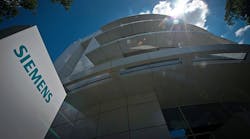Siemens AG (IW 1000/34) announced plans to spin off its $15 billion health-care division to help drive investments at one of its most successful units, in one of the biggest portfolio revamps at the German engineering giant that narrows its focus on energy, transport and factory gear.
The company is pursuing a public listing of the asset, with details on the planned scope and timing to follow, Siemens said Thursday as it announced earnings. Profit from so-called industrial operations reached 2.45 billion euros (US$2.68 billion) in the three months through September, little changed from the year-earlier period. Analysts had predicted an average of 2.41 billion euros, according to a Bloomberg survey.
”Health care is one of the most attractive business, if not the most attractive we have in the company,” Chief Executive Officer Joe Kaeser said in an interview with Bloomberg TV. ”We believe we want to focus it more.”
Siemens is betting that its health-care unit can capture growth better as a stand-alone business, though the company would seek to retain control of the asset, according to Chief Financial Officer Ralf Thomas. Kaeser has been shifting the company toward its energy divisions, which include its wind-turbine business, and the CEO said he doesn’t expect any demand swings in that field from Donald Trump’s ascent to the White House.
Siemens rose as much as 3 euros, or 2.9%t, to 107.5 euros in Frankfurt, and traded at 107.2 euros at 9:09 a.m. The stock has gained 19% so far this year, making it the third-best performer on Germany’s benchmark DAX Index in the period.
Siemen's Sprawling Portfolio
The plan to list its health-care unit further whittles down the company’s sprawling portfolio, which includes high-speed trains, wind turbines and medical scanners. Over the past decade, Siemens has largely retreated from consumer-oriented products and focused on industrial applications, selling areas like phones, light bulbs and hearing aids. Among Siemens’s biggest recent divestments was the Osram lighting unit, though Thomas said it would be “wrong to compare” the asset with health care.
Sales in the fourth quarter rose 3% to 21.95 billion euros, while orders slipped 14% after the company took in some large orders in the year-earlier period. The power and gas division led sales growth with a 10% increase, while process industry and drives was the only division to report a decline in sales, driven by increased price pressure. The division was also hurt by 199 million euros in charges related to job cuts in Germany.
The announced health-care spinoff is a ”positive surprise,” despite the market expecting the move, said Ben Uglow, an analyst at Morgan Stanley in London. The lack of a more concrete timeline makes it hard to judge the move further, he said.
”Whether this happens in 2017, 2018, or 2019 is anyone’s guess,” Uglow said.
For the 2017 fiscal year, Siemens expects earnings per share of 6.80 euros to 7.20 euros. Kaeser had previously cautioned about rising geopolitical uncertainty that could dampen 2017 results, and he reiterated today that Siemens continues to anticipate “headwinds” for macroeconomic growth amid a “complex geopolitical environment.” Sales growth will be between 1% and 2% in 2017, while the margin from industrial businesses will reach 10.5% to 11.5%, Siemens said.
The company expects 85% of its under-performing businesses to reach target margins of 6% by the end of the 2017 fiscal year. Currently these businesses have an average margin of 3%.
The company plans to pay a dividend of 3.60 euros per common share.
By Oliver Sachgau



